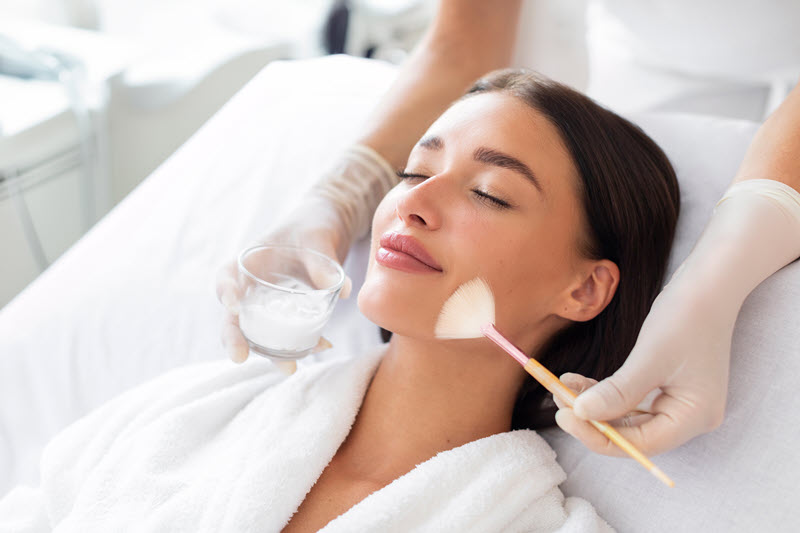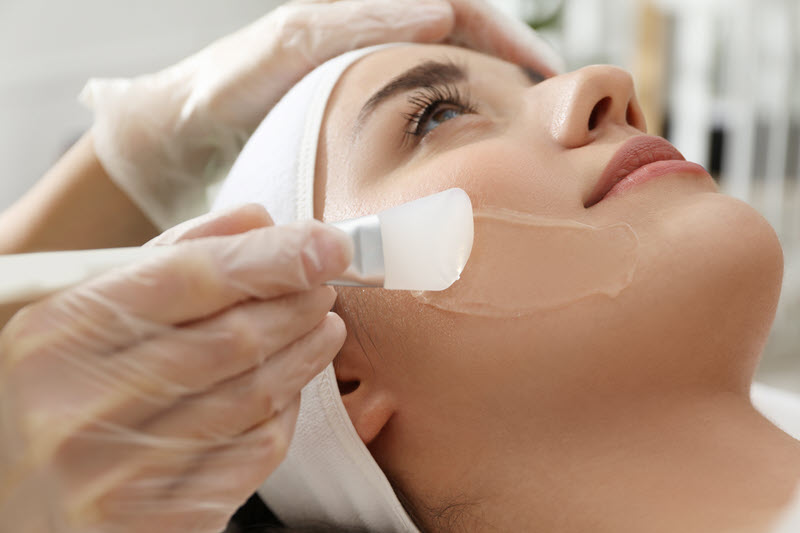Hyperpigmentation is a skin condition manifested as dark patches of skin, usually on the face, neck, and hands. It results from melanin overproduction, as the body reacts to extended sun exposure. Hyperpigmentation is not harmful, but it can affect the patient’s self-esteem.
While topical treatments, daily sunscreen use, and avoiding the sun provide some level of prevention and protection, many patients wish to see a more noticeable improvement in their skin condition. That’s where chemical peels come in.
This article explains how chemical peels for hyperpigmentation work and recommends different chemical peel types depending on the patient’s skin and aesthetic goals.

Does a Chemical Peel Remove Hyperpigmentation?
Chemical peels safely and effectively remove dark spots and other pigmentation concerns. The treatment involves the use of a chemical solution to exfoliate the skin’s top layer (epidermis), improve cell turnover (shedding dead skin cells), remove excess melanin, and resurface brighter, even-toned skin. Medical providers usually use acids that vary in concentration and potency, tailoring the treatment to suit the patient’s skin type and severity of hyperpigmentation.
Best Chemical Peels for Hyperpigmentation
Medical providers usually use light and medium chemical peels for pigmentation concerns, such as freckles, sunspots, age spots, and melasma. They are safer and less invasive than deep peels and deliver noticeable results.
Light Chemical Peels
Light chemical peels contain mild, low-concentration alpha-hydroxy (AHA) and beta-hydroxy acids (BHA) that peel superficial skin layers and regenerate the skin.
Alpha-Hydroxy Acids
AHAs typically used for hyperpigmentation include glycolic, lactic, and mandelic acids. Glycolic acid is the most commonly used and it is often mixed with other acids to accommodate light and dark skin types. Mandelic acid has the largest molecules and penetrates the skin slowly, so it suits patients with sensitive skin and conditions such as rosacea.
Beta-Hydroxy Acids
Salicylic acid is the beta-hydroxy acid typically used for pigmentary disorders. It is particularly beneficial for oily, acne-prone skin because it regulates sebum production and has anti-inflammatory properties. It is also suitable for darker skin tones and patients experiencing post-inflammatory hyperpigmentation (dark spots following inflammatory injury, acne, etc.). Newer chemical peels combine salicylic acid with glycolic or mandelic acid.
Medium Chemical Peels
Medium chemical peels dissolve the epidermis and penetrate deeper skin layers, stimulating new skin growth and increased collagen production. They are recommended for more severe sun damage.
Medium peels typically contain trichloracetic acid (TCA) alone or combined with other ingredients, such as glycolic acid, mandelic acid, and Jessner’s solution (a mix of salicylic and lactic acids and resorcinol). Patients with darker skin tones are more at risk of post-inflammatory hyperpigmentation following the treatment, so they should use lower concentrations of TCA.
At-Home Peels for Hyperpigmentation
At-home chemical peel solutions allow patients to treat discoloration concerns without leaving their homes. This option is convenient, budget-friendly, and effectively cleanses the skin, removing dirt and dead skin cells.
However, at-home solutions contain low acid concentrations for safety reasons. They require more treatments to fade dark spots and can’t match the results provided in a medical professional’s office.
Vibrant Skin experts recommend their Biome Enzyme Cleanser – Cleanse, which contains gentle peeling agents, including lactic acid, willow bark (a natural source of salicylic acid), and enzymes that act as exfoliants (e.g., bromelain from pineapple and papain from papaya). Cleanse brightens and invigorates the skin, helping to even out skin tone.
How to Choose the Right Chemical Peel for Hyperpigmentation?
Patients are advised to consult an experienced, trustworthy medical provider at a reputable clinic or med spa. They will create a customized chemical peel for their unique skin type, skin color, and the severity of hyperpigmentation.
Light and medium peels containing AHAs, BHAs, and TCA are the most commonly used solutions. The provider determines the right combination of chemical acids and their concentration to ensure the safe removal of excess melanin buildup and dark spots.
How to Prepare for a Chemical Peel for Hyperpigmentation?
Adequate preparation for the chemical peel enhances the results and decreases the risk of post-inflammatory hyperpigmentation.
Medical providers often recommend priming the skin for several weeks before the procedure. Priming involves applying a depigmenting agent, such as hydroquinone, tretinoin, glycolic acid, and kojic acid. This ensures uniform penetration of the chemical solution on the day of the treatment and facilitates healing.
Patients may also need to take antiviral medication for seven days before the treatment, avoid tanning, and forgo cosmetic treatments, such as facials, laser resurfacing, and hair removal.
Note: Learn how chemical peels and laser resurfacing differ and which treatment is more effective for your skin concern.
What to Expect During a Chemical Peel for Hyperpigmentation?

After the medical provider has prepared the appropriate chemical peel, they clean the treatment area and apply the chemical solution. In the case of medium peels, they may sedate the patient.
The chemical solution remains on the skin for several minutes. The provider uses water, a saline compress, or a neutralizing solution to remove the peel.
The treatment lasts 15-60 minutes. Patients typically feel slight stinging but no pain because the providers use gentle ingredients or sedating/numbing agents.
What Are the Results of a Chemical Peel for Hyperpigmentation?
The treatment’s effectiveness depends on several factors, including the severity of hyperpigmentation, the chemical peel type, the number of sessions, and whether the patient follows the provider’s aftercare recommendations.
In many cases, chemical peels succeed in fading or eliminating dark spots, melasma, and other pigmentary concerns. Additional benefits include fewer wrinkles, a smoother texture, and a glowing complexion.
How Many Chemical Peels are Needed to Remove Hyperpigmentation?
The number of sessions required depends on the severity of the patient’s hyperpigmentation and chemical peel type. Patients taking light and medium peels need at least three to six visits spaced two to four weeks apart to notice an improvement in their skin tone.
How Long Does It Take for Hyperpigmentation to Fade After a Chemical Peel?
It takes several weeks to several months for dark skin patches to fade after a series of chemical peel treatments. Deep hyperpigmentation concerns like melasma can take even longer. The quality of the treatment, consistent aftercare, and the regular use of sunscreen help speed up the process.
Side Effects of Chemical Peels for Hyperpigmentation
Depending on the chemical peel type, acid concentrations, and the patient’s sensitivity, the following side effects may occur:
- Redness
- Swelling
- Burning
- Stinging
- Flaking and peeling skin
- Blisters
- Crusting
- Scarring
- Post-inflammatory hyperpigmentation
- Infection
Should Anyone Avoid Chemical Peels for Hyperpigmentation?
Chemical peels are an effective treatment for patients with mild to moderate hyperpigmentation concerns, such as dark spots, melasma, and post-inflammatory hyperpigmentation.
The treatment is not suitable for people with the following conditions:
- Pregnancy
- History of scarring
- History of cold sores
- Skin injuries
- Skin infections
- Taking acne medications
Chemical Peels for Hyperpigmentation Aftercare
These aftercare tips following light and medium chemical peels optimize treatment results and reduce the risk of side effects.
- Avoid direct sun exposure.
- Apply sunscreen when you leave the house.
- Avoid sources of heat like saunas and tanning beds.
- Don’t engage in strenuous exercise for 24 hours.
- Don’t rub, scratch, or stretch the treated skin.
- Use gentle skincare products.
Note: Take a deeper dive into the dos and don’ts of chemical peel aftercare in our article.
Chemical Peels for Hyperpigmentation FAQ
The following section provides answers to some of the most common concerns that arise among chemical peel patients.
Why Are My Dark Spots Darker After a Chemical Peel?
Some patients experience post-inflammatory hyperpigmentation after a chemical peel. It can occur due to several factors, including the patient’s skin tone, inadequate depth and type of chemical peel, the provider’s inexperience, and a lack of proper aftercare.
While post-inflammatory hyperpigmentation is usually temporary, it may require additional treatments, including more chemical peels, laser resurfacing, and topical lightening agents.
Do Chemical Peels Permanently Remove Hyperpigmentation?
Chemical peels can significantly reduce or even eliminate existing pigmented skin cells. However, new dark spots can appear in the same area due to excessive sun exposure, acne breakouts, hormonal changes, medications, etc. Consistent skin care and sun protection are key in maintaining the results.
How Much Do Chemical Peels for Hyperpigmentation Cost?
Chemical peel prices vary depending on the peel type and the medical professional’s expertise.
At Vibrant Skin Bar, light peel costs $99 and medium peel costs $125. It includes a consultation and a personalized chemical peel solution.
Conclusion
A chemical peel is a versatile cosmetic treatment that improves various skin issues caused by sun damage and aging. The treatment effectively alleviates hyperpigmentation, helping to fade dark spots and bring out a smooth, fresh, and even-toned complexion.


